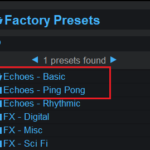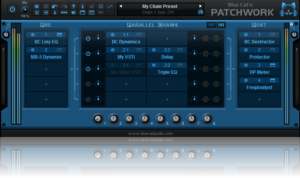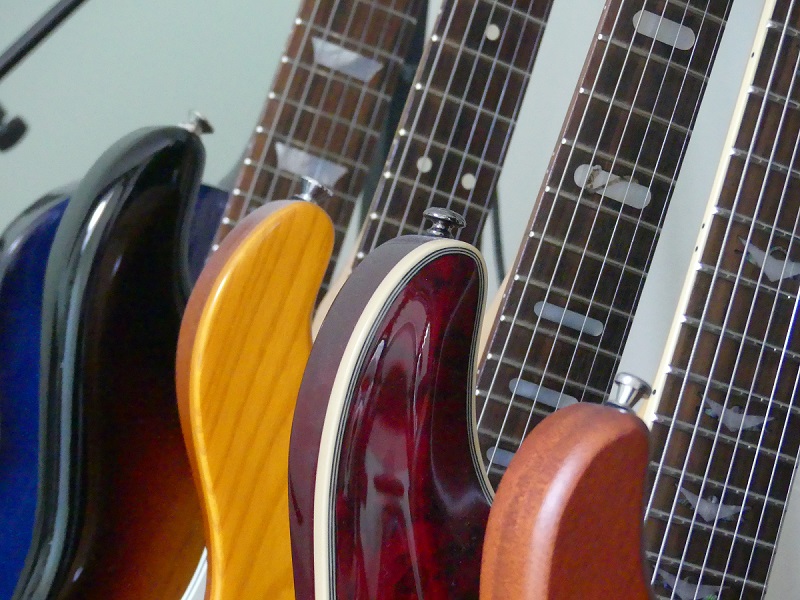33 releases and counting! Not bad for a small utility plug-in launched (almost) 10 years ago! That’s more than 300 new features and enhancements over the years and thousands of happy customers using it daily!
Blue Cat’s PatchWork (product page) recently hit version 2.65, and was first released in 2013, 2 years after the MB-7 Mixer plug-in, that was already able to third host party plug-ins, but in a multiband environment.
Let’s see the story behind this plug-in that has also become an application and can now be found in many sessions all over the world.
2013 – PatchWork V1 Launch
The first version was released in October 2013 and was already updated 3 times the first few months, to improve compatibility and add parameters mapping (which have now become macro parameters).
The idea behind Patchwork was to build a simple utility plug-in that could be used as a cross-platform / cross-DAW channel strip: you can create your audio processing chains with plug-ins from multiple formats and reuse them anywhere, anytime.
Of course, parallel processing was available from the beginning too, to help with audio routing that can become quite complex and is different from DAW to DAW.
2014 – PatchWork Standalone / MIDI & Audio Unit Support
What a busy year, with 6 free updates!
Among many other improvements and compatibility fixes, 2014 brought MIDI routing support to the table, making it very easy to use MIDI plug-ins and route MIDI between plug-ins (which is often a nightmare or impossible in DAWs). This greatly improved the workflow for virtual instruments and MIDI effect plug-ins, which happened to come back to the audio plug-in scene a few years ago.
The new version also supported the Audio Unit plug-in format on Mac, for maximum compatibility.
And last but not least, PatchWork was released as a standalone application, to let you load and use plug-ins quickly without having to launch a full-featured DAW app!
2015 – Audio Routing: Side Chain & Auxiliary Outputs / Plug-in I/O
In addition to multiple improvements here and there and compatibility fixes (with so many DAWs and plug-ins, it’s a never-ending task), 2015 brought many changes to improve the flexibility of PatchWork.
With a side chain input for the FX version and multiple output busses for the instrument version, PatchWork could now receive and send audio from and to multiple audio tracks within a DAW. This was also the opportunity to add audio I/O selection for each plug-in and instance, so that you can decide how to apply each plug-in to each audio channel.
2016 – VST3 Support
2016 was the year of VST3, PatchWork now supporting both the plug-in format as a plug-in and also as a host (you can load VST3 plug-ins).
2017 – PatchWork V2: new GUI / Built-in Effects
With PatchWork V2, the user interface was completely redesigned, with new graphics of course, but also with many other usability improvements to streamline the workflow.
It was also the arrival of built-in effects in PatchWork (borrowed from the new Late Replies creative delay plug-in), transforming our utility channel strip software into a full featured multi effects processor!
Yes that was another pretty busy year for PatchWork and its customers!
2018 – Drag And Drop & More Effects
With a brand new GUI, it was time to add drag and drop support in PatchWork V2!
2018 also brought a couple of new built-in plug-ins, in addition to the now usual improvements and fixes.
2019 – Presets Navigation

2019 mainly brought a new presets browser with built-in search to make it easier to manage your effect chains. It became also possible to change presets and banks via MIDI, and more built-in plug-ins were added.
2020 – Tone Maps
Tone Maps, a brand new way of creating new sounds easily, were imported from Blue Cat’s Destructor and applied PatchWork’s built-in effects.
If you have not used this feature yet, check it out!
2021 – Multicore & Apple Silicon Support
2021 was the year of performance!
With Apple M1 and multicore support for parallel chains, PatchWork became an audio processing workhorse!!
2022 – Macro Controls & Network Mode
This year, it was time to transform the simple parameters mapping introduced in 2013 into a complete macros system, with the ability to map multiple parameters from different sources and with different ranges into true macros.
You can now build your own plug-ins from multiple plug-ins with a simple user interface, as shown in this video!
With the release of Connector, it was also the opportunity to add a network server mode to PatchWork and process effects or virtual instruments remotely!
2023 – Colors, Oversampling And…?
It’s just the beginning of the 2023, and PatchWork was already updated, adding plugins oversampling, custom colors for plug-in slots and more…
Conclusion
With all these improvements over the years, PatchWork has become the de-facto standard to build channel strips with your favorite effect chains and share them between DAWs, regardless of the plug-in formats.
Want to play music without having to launch a full featured (and slow) DAW? Launch the lightweight Patchwork application, load your preset and play!
Need to load VSTs in Pro Tools or Logic, Audio Units in Cubase? No problem, PatchWork can do that for you!
Need MIDI FX support in Reason or Maschine? Load your effects and instruments in PatchWork and do the MIDI routing there!
Not enough CPU on your audio machine, or you need to use Windows plug-ins from a Mac or vice versa? Launch PatchWork in network mode on another computer and make it process your effects there…!
Try Patchwork for yourself and be amazed
by what you can achieve with it!
>discuss this topic on the forum















Yes, this is a great tool!
Writing this while PatchWork is running hosting Plug’n Script instance 🙂
Thank you for both of these!
Awesome, thanks! Glad that you like it!